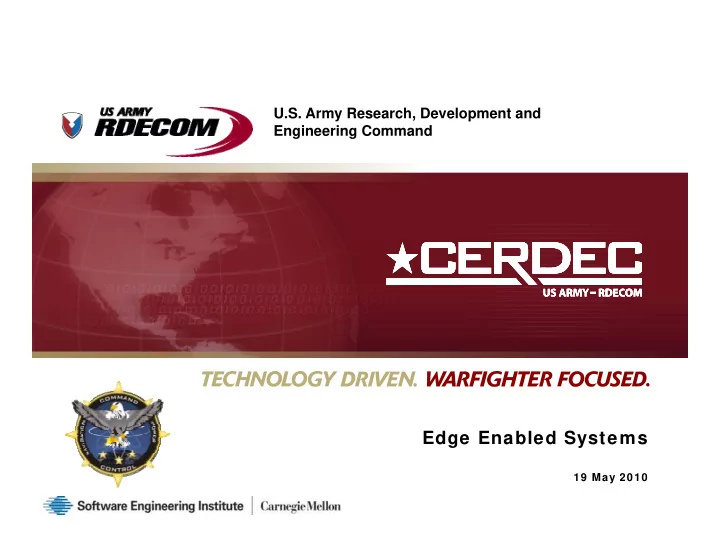

U.S. Army Research, Development and Engineering Command Edge Enabled Systems 19 May 2010
The Problem Traditional military systems are developed and fielded by programs of record – Adhere to strict acquisition policy (DoD 5000) – Discourage modifications by users in the field For good reasons: performance, security, availability, etc. But… Today’s Warfighters are engaged in asymmetric warfare, against a highly networked and agile enemy – Rely more than ever on information technology – Must adapt to changes in their environment and enemy tactics These are conflicting!
The Solution Warfighters have substantial and ever-increasing levels of technical skills – Some are capable of modifying systems in response to needs that were not anticipated by their designers Software the Warfighter uses must be adaptable
The Solution Cont’d We need to facilitate creativity and innovation “at the edge” without compromising core system qualities p g y q We call this Edge Enabled Systems (EESs)
The Rise of the Netw ork Yochai Benkler’s The Wealth of Networks : • we are in the midst of a “radical transformation” of how we create our information environment • this transformation is restructuring society; models of production and consumption production and consumption • Benkler calls this commons- based peer production p p
Service-Dominant Logic • Service industries account for 55% of economic activity in the United States t e U ted States • Businesses have moved from a goods-dominant view, to a Businesses have moved from a goods dominant view to a service-dominant view • In this new view customers are seen as co-creators of value
A Sea Change • These changes are much more than just a shift from goods to services to se ces • They are a reframing of the purpose of the enterprise and its They are a reframing of the purpose of the enterprise and its role in value creation • They are creating new phenomena, e.g. super-linear growth in projects emergent behaviors in systems in projects, emergent behaviors in systems…
Implications for the DoD • All change introduces risk, and all change is disruptive • Edge enablement is especially disruptive to an organization such as the Army where the consequences organization such as the Army where the consequences of risk may be life and death • Inhibitors: – Established Practices – Cultural Disconnect – Information Assurance and Policy – Security and Classifications
A New Model • We suggest that a new model of gg software creation is needed, based on the Metropolis Model • This model helps us think about system creation that is system creation that is commons-based and peer produced: p – MySpace, YouTube, Twitter, Facebook, Hi5, Wikipedia, Orkut, Craigslist Craigslist , …
Metropolis Systems All successful EESs and organizations share a common structure: common structure: Masses A Metropolis structure: Periphery – the core ensures critical (D (C (P Customers) Prosumers) (E End User) evelopers) system qualities Core – users (developers, prosumers) are enabled at the edge
Metropolis Model Characteristics 1. Mashability 2. Conflicting, Unknowable Requirements 3. Continuous Evolution 4. Focus on Operations 5. Open Teams 6. Sufficient Correctness 7. Unstable Resources 8. Emergent Behaviors
Managing the Edge • What mechanisms can be employed for facilitating the edge? • What are their advantages and disadvantages?
Mechanisms for Managing the Edge • Configuration Configuration • Scripting • Application Platforms Application Platforms • Sandbox • Qualification Qualification • Monitoring • Adaptive Need-to-know Information Access Adaptive Need to know Information Access
A New Model of Softw are Development and Acquisition • The “Edge” is the intersection between users and their operating environments • If future systems are to be EESs then the organizations that are tasked to build these systems must change.
Recommendations • Leadership and Management • Project Structure and Communications • Requirements Management • Quality Assurance • Architecture • Delivery Mechanisms
Moving Forw ard • An EES creates operational risks, as compared with the “locked down” systems of today “locked down” systems of today • A locked-down system also creates risks—from being poorly aligned with the needs of the Warfighter poorly aligned with the needs of the Warfighter
Resulting Questions • How adaptable should the system be? • Wh t d What development principles should be employed to maintain to ensure l t i i l h ld b l d t i t i t EESs? • What project management procedures and methods should be applied p j g p pp to EESs? • What fundamental changes must occur in the QA process during fielding and operating of an EES? and operating of an EES? • What fundamental changes must occur in the acquisition organization and their processes? • Does an organization provide additional incentives to the participants?
Recommendations • To make progress in enabling the edge we believe a documented, repeatable method is required, including: – a classification of edge problems and selection of problems for experimentation – empirical analysis of EES mechanisms empirical analysis of EES mechanisms – development of an Edge design and evaluation methodology
Recommend
More recommend